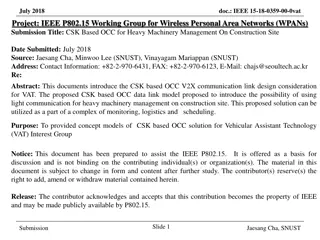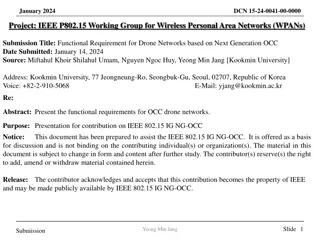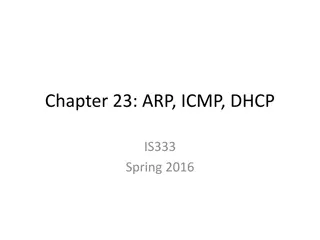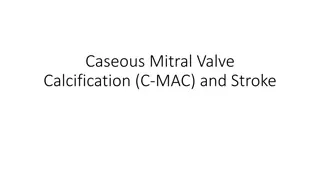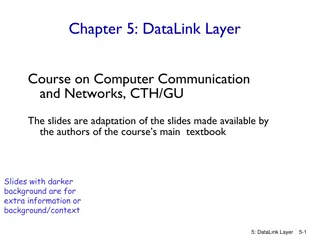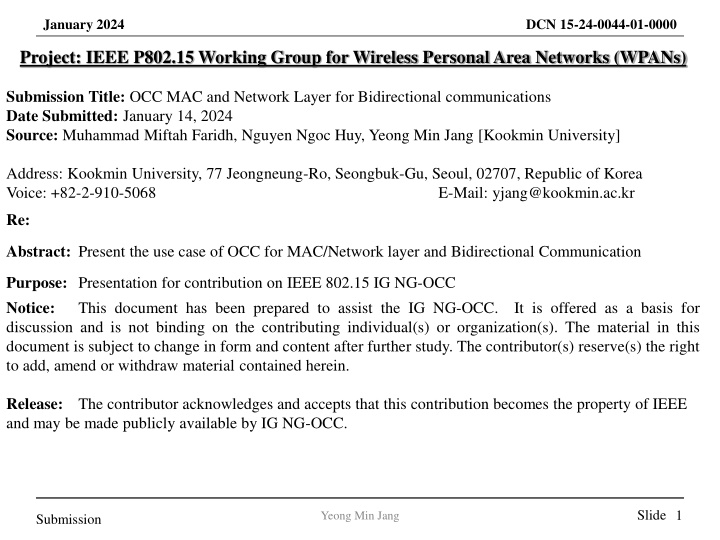
Enhancing Wireless Personal Area Networks with OCC MAC and Network Layer for Bidirectional Communications
Explore the utilization of Optical Camera Communication (OCC) for MAC and network layers in bidirectional communication, addressing challenges and proposing new methodologies for improved efficiency, security, and collision avoidance in wireless personal area networks.
Download Presentation

Please find below an Image/Link to download the presentation.
The content on the website is provided AS IS for your information and personal use only. It may not be sold, licensed, or shared on other websites without obtaining consent from the author. If you encounter any issues during the download, it is possible that the publisher has removed the file from their server.
You are allowed to download the files provided on this website for personal or commercial use, subject to the condition that they are used lawfully. All files are the property of their respective owners.
The content on the website is provided AS IS for your information and personal use only. It may not be sold, licensed, or shared on other websites without obtaining consent from the author.
E N D
Presentation Transcript
January 2024 DCN 15-24-0044-01-0000 Project: IEEE P802.15 Working Group for Wireless Personal Area Networks (WPANs) Submission Title: OCC MAC and Network Layer for Bidirectional communications Date Submitted: January 14, 2024 Source: Muhammad Miftah Faridh, Nguyen Ngoc Huy, Yeong Min Jang [Kookmin University] Address: Kookmin University, 77 Jeongneung-Ro, Seongbuk-Gu, Seoul, 02707, Republic of Korea Voice: +82-2-910-5068 E-Mail: yjang@kookmin.ac.kr Re: Abstract: Present the use case of OCC for MAC/Network layer and Bidirectional Communication Purpose: Presentation for contribution on IEEE 802.15 IG NG-OCC Notice: This document has been prepared to assist the IG NG-OCC. It is offered as a basis for discussion and is not binding on the contributing individual(s) or organization(s). The material in this document is subject to change in form and content after further study. The contributor(s) reserve(s) the right to add, amend or withdraw material contained herein. Release: The contributor acknowledges and accepts that this contribution becomes the property of IEEE and may be made publicly available by IG NG-OCC. Slide 1 Yeong Min Jang Submission
January 2024 DCN 15-24-0044-01-0000 OCC MAC and Network Layer for Bidirectional communications January 16, 2024 Slide 2 Yeong Min Jang Submission
January 2024 DCN 15-24-0044-01-0000 Contents Background Methodology Conclusion Slide 3 Yeong Min Jang Submission
January 2024 DCN 15-24-0044-01-0000 Background Challenges of Bidirectional OCC: Limited field of view and hidden node problem High computational demands for real-time processing Security concerns with visible light transmissions Current MAC Mechanisms: Need for efficient collision avoidance and hidden node mitigation Slide 4 Yeong Min Jang Submission
January 2024 DCN 15-24-0044-01-0000 Methodology: 1. New MAC Protocol for OCC (CSMA with collision detection and hidden avoidance; CSMA/CD-HA) CSMA/CD-HA protocol: This protocol addresses the hidden node problem and ensures fair access to the channel. Intra-frame bidirectional transmission: Data is exchanged within the same frame, allowing for faster and more efficient communication. Directional communication: Devices can focus their light beams on specific receivers, improving efficiency and reducing interference. Adaptive backoff mechanism: This mechanism helps to avoid collisions and further improves channel utilization. Increasing the backoff time after a collision: This gives other devices more time to access the channel. Adapting the backoff time based on channel conditions: In congested networks, backoff times are increased to avoid further collisions. Slide 5 Yeong Min Jang Submission
January 2024 DCN 15-24-0044-01-0000 Methodology: Comparison between the CSMA/CD-HA and the current MAC standardization CSMA/CA Feature CSMA/CD-HA CSMA/CA Collision Handling Detection and Hidden Area Avoidance Avoidance through carrier sensing and backoff Hardware Complexity Higher Lower Latency Higher Lower High reliability, collision avoidance Low latency, tolerable collisions Suitability Slide 6 Yeong Min Jang Submission
January 2024 DCN 15-24-0044-01-0000 Methodology: 2. PRU-Based Architecture Programmable Realtime Unit (PRU) Integration: Offloads real-time OCC tasks from the main processor for improved performance and reduced latency. Functions Handled by PRU: Real-time signal processing Modulation and demodulation Collision detection and hidden node identification Packet scheduling and transmission Shared Memory Communication: Enables efficient data exchange between the PRU and the main processor. Slide 7 Yeong Min Jang Submission
January 2024 DCN 15-24-0044-01-0000 Methodology (OCC MAC and Network Layer for Bidirectional communications) Conduct a controlled experiment to validate the OCC prototype's performance. Slide 8 Yeong Min Jang Submission
January 2024 DCN 15-24-0044-01-0000 Conclusion The CSMA/CD-HA protocol enhances efficiency by detecting hidden nodes and employing directional communication, while adaptive backoff dynamically adjusts transmission attempts. PRU integration offloads real-time tasks, optimizing performance. Improved reliability is ensured through collision detection, hidden area avoidance, and intra-frame bidirectional transmission. The system's greater scalability is facilitated by a flexible protocol design and shared memory communication, accommodating diverse network configurations and fostering wider adoption. Slide 9 Yeong Min Jang Submission
January 2024 DCN 15-24-0044-01-0000 References : B. G. Guzman, M. S. Mir, D. F. Fonseca, A. Galisteo, Q. Wang, and D. Giustiniano, Prototyping visible light communication for the internet of things using OpenVLC, IEEE Commun. Mag., vol. 61, no. 5, pp. 122 128, 2023. Slide10 Yeong Min Jang Submission











